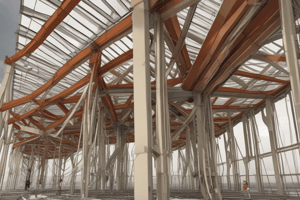Podcast
Questions and Answers
Qu'est-ce que la charge de vent sur une structure métallique?
Qu'est-ce que la charge de vent sur une structure métallique?
- La force exercée par la pluie sur une structure
- La force exercée par le soleil sur une structure
- La force gravitationnelle sur une structure
- La force exercée par le vent sur une structure (correct)
Quel est l'unité de mesure de la charge de vent?
Quel est l'unité de mesure de la charge de vent?
- kg
- °C
- m/s
- psf (correct)
Quel facteur affecte la charge de vent sur les structures métalliques en fonction de leur emplacement géographique?
Quel facteur affecte la charge de vent sur les structures métalliques en fonction de leur emplacement géographique?
- La vitesse et la direction du vent (correct)
- La densité de population
- La végétation environnante
- La proximité des commerces
Comment la hauteur d'une structure influence-t-elle la charge de vent qu'elle subit?
Comment la hauteur d'une structure influence-t-elle la charge de vent qu'elle subit?
Quel impact les obstructions telles que les bâtiments ou les arbres peuvent-elles avoir sur la charge de vent d'une structure métallique?
Quel impact les obstructions telles que les bâtiments ou les arbres peuvent-elles avoir sur la charge de vent d'une structure métallique?
Qu'est-ce qui peut influencer la charge de vent qu'une structure métallique subit?
Qu'est-ce qui peut influencer la charge de vent qu'une structure métallique subit?
Pourquoi les ingénieurs considèrent-ils la directionnalité du vent lors du calcul des charges de vent?
Pourquoi les ingénieurs considèrent-ils la directionnalité du vent lors du calcul des charges de vent?
Quelles mesures peuvent être prises pour atténuer les effets des charges de vent sur les structures métalliques?
Quelles mesures peuvent être prises pour atténuer les effets des charges de vent sur les structures métalliques?
Quel outil peut offrir une analyse automatisée des charges de vent pour les structures métalliques?
Quel outil peut offrir une analyse automatisée des charges de vent pour les structures métalliques?
Quel type de mesures pour contrer les charges de vent implique l'utilisation de ventilateurs, jets ou capteurs?
Quel type de mesures pour contrer les charges de vent implique l'utilisation de ventilateurs, jets ou capteurs?
Flashcards are hidden until you start studying
Study Notes
Wind Load Analysis on a Metallic Structural Hangar: Climatic Actions
Understanding Wind Loads
The analysis of wind loads on metallic structures, such as hangars, is crucial for ensuring the safety and longevity of these structures. Wind load, also known as wind force, is the force exerted by the wind on a structure. It is measured in pounds per square foot (psf) or newtons per square meter (N/m²) and can cause significant stresses, displacements, vibrations, and failures if not properly considered in the design and analysis process.
Factors Affecting Wind Loads on Metallic Structures
Geographical Location
The geographical location of a metallic structure plays a significant role in determining the wind load it experiences. Wind speed and direction can vary greatly between different locations, with areas near coasts, mountains, or open plains experiencing higher wind loads.
Height
The height of a structure increases the wind load experienced, as wind speed generally increases with altitude. Taller structures, such as high-rise buildings and tall towers, experience significantly higher wind loads compared to lower structures.
Surrounding Topography
The immediate surroundings of a structure, such as nearby buildings, trees, or other obstructions, can affect the wind load it experiences. Urban environments and areas with dense foliage can lead to increased wind loads due to the turbulence generated by these obstructions.
Building Design and Orientation
The shape, size, and orientation of a structure can also influence the wind load it experiences. Flat and gable roofs, for example, have different wind pressure distributions compared to other roof shapes. Additionally, the exposed surfaces of a structure face varying wind pressures, depending on their orientation to the prevailing wind directions.
Calculating Wind Loads on Metallic Structures
The American Society of Civil Engineers (ASCE) provides standardized guidelines, such as ASCE 7-16, for calculating wind loads on structures. These guidelines consider factors such as geographical location, building design, and exposure conditions to provide consistent and accurate wind load estimates.
Engineers follow a systematic approach to calculate wind loads on metallic structures, starting with determining the risk category and basic wind speed for the structure. The next step involves considering wind directionality, which accounts for the shape, size, and height of the structure, as well as the surrounding terrain. External pressure coefficients for the structure's main wind-force resisting system (MWFRS) and components and cladding system are then calculated, taking into account the specific details of each part.
Mitigating Wind Load Effects on Metallic Structures
Structural engineers can employ various strategies to address the adverse effects of wind loads on metallic structures, including enhancing the structural design, modifying the shape or layout of the structure, and implementing passive or active wind load mitigation measures.
Passive measures include modifications to the structure's shape, size, orientation, or stiffness. Adding aerodynamic features, bracings, dampers, or mass to the structure can help alleviate wind load effects. Active measures, on the other hand, involve the application of external forces or controls to counteract the wind load, such as using fans, jets, actuators, or sensors.
Tools for Wind Load Analysis
Various tools and resources can aid in the wind load analysis of metallic structures, such as structural analysis software like ClearCalcs, which offers automated wind load analysis capabilities. Advanced tools, such as finite element analysis (FEA) software, computational fluid dynamics (CFD) simulations, and wind engineering and simulation (WES) software, can provide valuable insights into the wind load behavior of complex metallic structures.
Studying That Suits You
Use AI to generate personalized quizzes and flashcards to suit your learning preferences.




